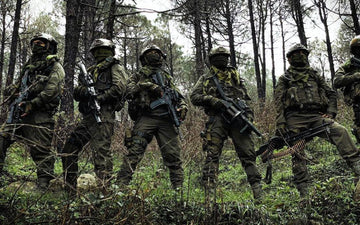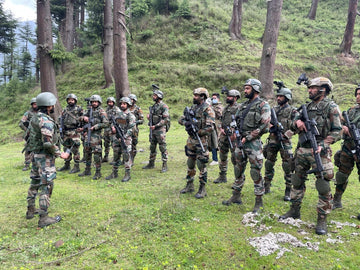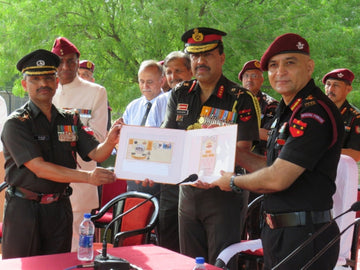Historical Context
The roots of the Indian Para Commandos can be traced back to India’s independence in 1947, when the need for specialized forces became apparent during the conflicts that followed. Originally formed as part of the Para Brigade within the Indian Army, these units were tasked with challenging missions that conventional forces struggled to tackle.
Over the decades, the operational scope of the Para Commandos expanded, leading to their involvement in several key operations— from counter-insurgency missions in Kashmir to operations in Sri Lanka and beyond. The elite status of these commandos was solidified over time, leading to the creation of various badges to recognize their specialized skills and achievements.
The following sections delve deeper into the myriad of badges earned by the Para Commandos, exploring their significance, eligibility, and design, painting a vivid picture of what it means to be part of this formidable unit.
The Badges of the Para Commandos
Balidaan Badge
Significance: The Balidaan Badge holds a revered status among the badges awarded to the Para Commandos. This emblem serves as a poignant reminder of the spirit of self-sacrifice and unwavering dedication to the defense of the nation. The very essence of this badge lies in its representation of the ultimate sacrifice a soldier may make in the line of duty.
Eligibility: Achieving the Balidaan Badge is a formidable task. It is awarded to only 4-5 volunteers from every 100 selected for Special Forces training, showcasing the high standards and aptitude required. Additionally, doctors who complete their probation in the unit, as well as personnel who achieve their first confirmed kill, are also eligible for this prestigious accolade.
Design: The badge features a dagger—symbolizing combat prowess—pointing downward, flanked by wings that stretch upwards, conveying the dual elements of strength and aspiration. The word "Balidaan" is displayed in Devanagari script, adding a cultural significance to the badge’s symbolism.
Wear: This ornate badge is worn beneath the right pocket of the uniform, serving as a constant reminder of the soldier's commitment to their comrades and country.
Special Force Badge
Significance: The Special Force Badge is a clear indicator of a soldier’s status within the PARA Special Forces. This badge embodies the unique abilities that set these soldiers apart, emphasizing their readiness to undertake exceptional missions that most would deem impossible.
Eligibility: The badge is awarded upon the successful completion of the probationary period of Special Forces training, which involves rigorous physical fitness, combat skills, and mental endurance.
Wear: It is worn on both the upper right and left sleeves, signifying the soldier's affiliation and accomplishments within the Special Forces.
Para Jump Wings
Significance: The Para Jump Wings are awarded to soldiers who complete the Parachute Training Course, validating their qualification as a paratrooper. This accomplishment is critical in establishing the foundation for various airborne operations.
Wear: The wings are typically worn on the left chest, often proudly displayed by soldiers as they showcase their airborne expertise.
ATGM Badge
Significance: The Anti-Tank Guided Missile (ATGM) Badge represents a soldier's proficiency in operating anti-tank weapons, a crucial skill in modern warfare where armored threats abound.
Eligibility: Soldiers earn this badge by successfully achieving target hits during the Battalion Support Weapon Course.
Wear: This badge is worn just above the name tag, highlighting the soldier's specialized skills in weaponry.
Combat Free Faller Badge
Significance: The Combat Free Faller Badge is awarded to candidates after they complete a rigorous combat free fall course, which comprises advanced parachuting techniques, including HALO and HAHO jumps from altitudes of 30,000 feet.
Wear: It is prominently worn above medals and ribbons, showcasing the skilled training the individual has achieved.
Shoulder Title
Significance: The shoulder title for Para Commandos reads “PARA SF,” an insignia that distinguishes them as members of these elite airborne units. This not only signifies their specialized training but also fosters a sense of identity and pride.
Regimental Badge
Significance: Each soldier within the Indian Army has a regimental badge reflecting their specific regimental affiliation. For the Parachute Regiment, this badge features an open parachute design, reinforcing their airborne heritage.
Jump Indicator Badge
Significance: This badge serves as a visual representation of a paratrooper's cumulative jumps. It is enhanced with stars or other symbols added to the para wings to denote the jump count, telling the story of the soldier's experience and commitment to airborne operations.
Diving Badge
Significance: Candidates who complete either air diving or sea diving courses earn the Diving Badge. This badge emphasizes the versatility and comprehensive skill set that the Para Commandos possess, skilled in both land and aquatic terrains.
Headgear
Significance: The iconic maroon beret is synonymous with the Para Commandos, signifying their airborne capabilities. When in service dress, the Balidaan badge is often displayed on the beret, underscoring the soldier’s elite status and dedication.
Real-World Applications and Case Studies
The badges earned by the Para Commandos are not merely decorative; they reflect the extensive training and operational capabilities that the soldiers possess. For instance, during the 2016 Uri surgical strikes, the skills represented by various badges came to the forefront. The successful execution of such a complex operation required deep commitment, unparalleled skill, and precise execution—qualities that can be attributed to the rigorous training signified by these badges.
Moreover, historical case studies like Operation Blue Star in 1984 and the Kargil War in 1999 showcase the prowess of the Para Commandos in their roles as elite operatives. Many commandos who have engaged in such operations have not only earned these badges but have also become national heroes, serving as inspiring figures for future generations. The high stakes and challenges highlight the importance of their training, symbolized through each badge, and the caliber of soldiering expected of those in the Special Forces.
Statistical Data and Research Insights
According to the Indian Army's recruitment statistics, the selection process for the Para Commandos is highly competitive. Only a fraction of volunteers—about 4-5%—will earn the right to don the Balidaan Badge, with dozens more vying for the coveted Special Forces insignia. This competitive environment ensures that only those possessing exceptional physical and mental capabilities advance past the initial selection stage.
Furthermore, data from military exercises and simulated combat scenarios indicate that soldiers with specific proficiency badges (such as the ATGM Badge) have significantly higher success rates in their associated roles during real-world missions. This data underscores the importance of specialized training programs in improving operational effectiveness in high-pressure situations.
Challenges and Solutions
Despite the rigorous training and prestigious accolades, the journey to becoming a Para Commando comes with its challenges. Training is physically and mentally exhausting, often leading to high attrition rates. The psychological toll of performing high-stakes missions can also contribute to challenges in retention and mental health among soldiers.
Proposed Solutions
- Comprehensive Mental Health Programs: Ensuring soldiers have access to psychological support and counseling can help mitigate the mental challenges associated with their high-risk roles.
- Enhanced Training Protocols: Regularly updating training schedules to include more adaptive and tailored approaches could ensure soldiers remain engaged and better equipped for diverse operational scenarios.
- Support Systems for Families: Establishing robust support systems for the families of soldiers can help improve morale and overall mental health, thus enhancing performance.
Future Trends and Predictions
The future of the Para Commandos and their badges is undoubtedly linked to the ongoing evolution of warfare and operational tactics. As urban warfare, asymmetric threats, and technological advancements in battlefield environments continue to reshape military operations, the focus on specialized training and badge recognition will become more pronounced.
We can expect:
- Increased Use of Technology: Integration of advanced technologies such as drones and AI-driven tactical systems within training programs, leading to new badges that may reflect expertise in these domains.
- Collaborative Operations with Allied Forces: As multinational operations become more common, we may see standardization of certain training protocols and badges among allied Special Forces units.
- Emphasis on Diversified Skills: Future changes may see badges recognizing proficiency in critical areas such as cyber warfare or intelligence analysis, underscoring the need for commandos to adapt to rapidly changing military landscapes.
Conclusion
The various badges earned by the Para Commandos are more than mere insignia; they signify a journey of dedication, sacrifice, and exceptional skill. Each badge encapsulates the essence of what it means to serve in one of the most elite forces in the world. Recognizing their achievements not only honors those who have served but also inspires future generations to strive for excellence in service to the nation.
As we reflect on the significance of these symbols of honor, it's essential to acknowledge the commitment that goes into being a Para Commando—a commitment that represents the very best of the Indian Armed Forces. The essence of being a Para Commando transcends mere badges and training; it embodies a spirit of service, sacrifice, and unwavering patriotism. Thus, from the Balidaan Badge to the Para Jump Wings, each piece of insignia carries with it a profound story of valor and unwavering commitment to nation building.
The legacy of the Para Commandos will continue to inspire not only those who serve but also the millions who look up to them as embodiments of the fighting spirit of India. For anyone seeking to understand the heart of the Indian military, studying the badges of the Para Commandos offers profound insights and admiration.





